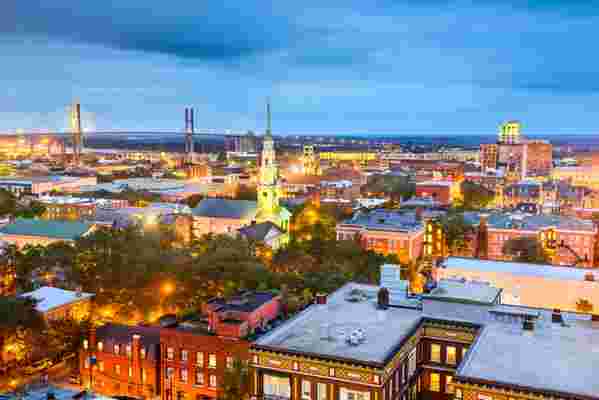Founded in 1733, Savannah, Georgia, was the country’s first planned city. With an elaborate design that boasted public squares, neoclassical architecture , and a road system that allowed the urban market to flourish, the city was ahead of its time. Today, the historic downtown is known for its unique infrastructure and breadth of architectural gems, attracting millions of visitors each year. Although the city will always lovingly celebrate its past, it is looking to the future with a 2018 redesign of the historic downtown area that will make better use of the waterside space and public areas, and improve the overall experience for residents and visitors alike. The city of Savannah tapped global urban design firm EDSA to take on the task, with an emphasis on preserving its rich history. AD spoke with John Torti, a senior associate at EDSA, about the firm’s design plans, the obstacles they faced, and how they intend to stay true to Savannah’s historic roots.

Savannah's downtown skyline as seen from across the Savannah River.
Architectural Digest: What are the primary reasons the city of Savannah is ready for a major redesign?
John Torti: Savannah is known for its rich history, and tourism is a vital component of the local economy. In recent years the historic downtown area has seen a surge in development projects, and the city thought it was an appropriate time to improve the public realm.
AD: Walk us through the plans.
JT: Once we understood the vision and created our guiding principles for the project we came up with two initial concepts for the community to react to. One focuses on the historical significance of the city, pulling cues from the city’s grid system, the use of live oak trees, and the historic building materials. The other ties in with the city’s relationship to the water, in this case the Savannah River, which really is the true lifeline of the city—it’s what brought the first ships there in 1733. This plan lends itself more towards wayfinding, using palm trees and nautical detailing to orient users in the downtown area and guide them to the river.
AD: How are you working with the community during this project?
JT: We’ve done a lot of consensus building within the community, it’s been an integral part of the design process. Throughout the conceptual design phase, which we actually just wrapped up, we had a series of six meetings with the public, and at each meeting we honed the design and got input from the residents and the city so we could ultimately create a cohesive design that works for all users.

EDSA met with local residents to ensure their design was meeting the city's expectations.
AD: What are some of the major challenges of redesigning a historic city?
JT: We often find certain needs from the community exceed the space we have to work with. This is very common when working in historical places, whether we have to work with existing buildings or 100-year-old oak trees, those things define the space that you have and as designers we need to get creative with the space allotted. Through several evolutions of planning, we began to work with the constraints and find a way to celebrate them in the process.
AD: What were you most excited about when taking on this project?
JT: As designers, nothing excites us more than to see our vision become reality. We focus on implementation and we pride ourselves on this. Creating a cohesive, innovative public space that enhances the quality of life for Savannah residents really brings us great joy.

A rendering shows EDSA’s plans for one of the main streets in downtown Savannah.
AD: Are there any eco-friendly initiatives involved in EDSA’s design?
JT: It’s always important for us to be as sustainable as possible, whether it’s the use of building materials or the type of infrastructure we implement. We have many different green goals, such as the use of bioswales and permeable paving that will reduce the amount of burden on the existing infrastructure. We also hope the city takes cues from this and begins to make these new standards for future projects.
AD: In what ways will Savannah benefit from the redesign?
JT: The ultimate plan, once implemented, will provide a safe, walkable public realm that enriches the quality of life for Savannah residents while continuing to exceed visitors’ expectations. It will be a design that celebrates the city’s natural and timeless beauty while preserving the history and tradition of Savannah—making it a model city for another century to come.

Leave a Reply